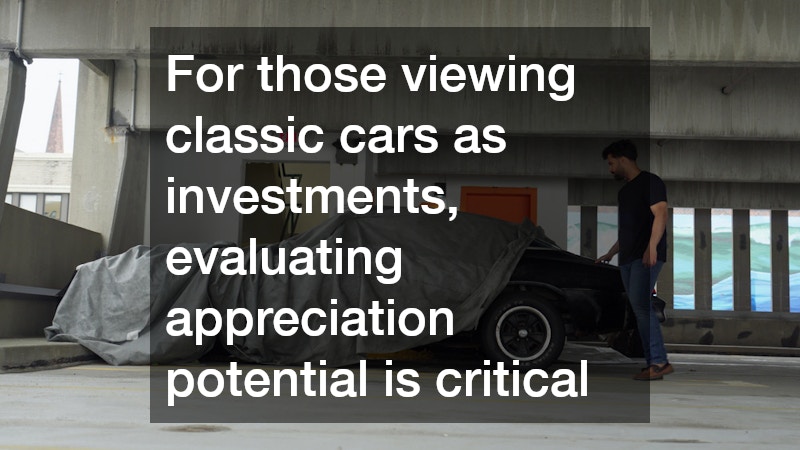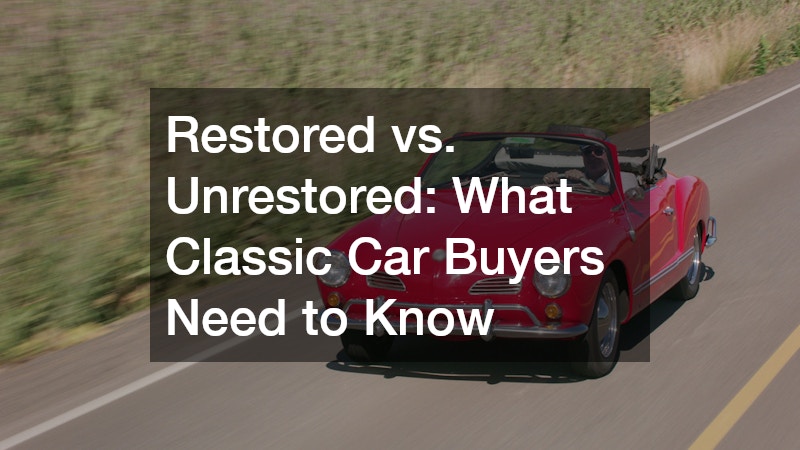The allure of classic cars captivates enthusiasts worldwide, offering a tangible connection to automotive history. These timeless vehicles evoke nostalgia and craftsmanship, drawing buyers into a world of mechanical artistry. A key decision for a Classic car buyer is whether to choose a restored classic, revitalized to its former glory, or an unrestored original, preserving its authentic charm. This article explores the differences, considerations, and factors influencing the choice between restored and unrestored classic cars.
What is the Difference Between Restored and Unrestored Classic Cars?
Definition of Restored Classic Cars
A restored classic car has been meticulously refurbished to its original factory condition or enhanced beyond its initial state. Restoration often involves comprehensive overhauls, including engine rebuilds, bodywork repairs, and interior refinishing. The goal is to rejuvenate the vehicle’s aesthetics and functionality, sometimes surpassing its original quality through modern techniques or materials. Restored classics appeal to those seeking a polished, show-ready vehicle.
Definition of Unrestored Classic Cars
Unrestored classic cars, often called “survivor” cars, retain their original parts, paint, and components with minimal or no alterations. These vehicles are valued for their authenticity and historical integrity, showcasing the patina and wear of their era. Unrestored classics exude a raw, unpolished charm that resonates with purists who appreciate their untouched state as a direct link to the past.
Key Differences in Value
Restored classic cars often command higher monetary value due to the labor, expertise, and resources invested in their refurbishment. High-quality restorations, especially those using original or period-correct parts, can significantly elevate a car’s market price. Conversely, unrestored cars may appeal to collectors who prioritize originality, sometimes fetching a premium for their untouched condition. The value of each depends on market trends, rarity, and buyer preferences, with some collectors willing to pay more for a well-preserved original over a restored counterpart.
Why Do Some Collectors Prefer Unrestored Classic Cars?
Authenticity and Originality
Unrestored classic cars are prized for their authenticity, embodying the exact specifications and imperfections from their production era. Collectors value the untouched nature of these vehicles, from original paint to factory-installed components, as they reflect the manufacturer’s intent. This authenticity offers a unique connection to the car’s history, unattainable in restored vehicles where modern interventions may alter the original character.
Historical Significance
Unrestored classics serve as time capsules, preserving the design, engineering, and cultural context of their era. They provide insights into past manufacturing techniques and automotive trends, acting as historical artifacts. For collectors, owning an unrestored car means safeguarding a piece of automotive heritage, complete with its original quirks and character, which many view as more valuable than a restored car’s polished perfection.
Potential for Personal Restoration
For some, the appeal of an unrestored classic lies in the opportunity to undertake a personal restoration project. Buyers may relish the chance to customize or restore the vehicle to their specifications, blending historical preservation with personal creativity. This hands-on process can be deeply rewarding, allowing owners to forge a unique bond with the car while tailoring it to their vision.
What Should Buyers Know About the Costs of Restoring Classic Cars?
Initial Purchase Cost vs. Restoration Costs
Unrestored classic cars typically have a lower initial purchase price, making them an attractive entry point for buyers seeking authenticity. However, restoration costs can quickly escalate, often surpassing the car’s initial cost. Expenses for parts, labor, and specialized services can accumulate, requiring buyers to carefully consider the financial commitment of restoring a vehicle versus purchasing one already restored.
Common Restoration Expenses
Restoring a classic car involves significant expenses, including sourcing rare or reproduction parts, professional labor, and refinishing services. Common costs include engine and transmission rebuilds, bodywork to address rust or damage, and interior refurbishment, such as reupholstering seats or replacing dashboards. Achieving historical accuracy often demands premium materials and skilled craftsmanship, further driving up costs.
Long-term Financial Considerations
Beyond restoration, maintaining a classic car requires ongoing investment. Vintage vehicles often need specialized care, such as climate-controlled storage, regular maintenance, and premium fuels or lubricants to preserve their condition. These long-term costs can strain budgets, emphasizing the importance of planning for both immediate restoration and sustained upkeep to protect the car’s value and functionality.
How Does the Condition of a Classic Car Affect Its Market Value?
Factors Influencing the Valuation of Restored Cars
The market value of a restored classic car depends on the quality and authenticity of the restoration. Key factors include the use of period-correct parts, matching numbers (where the engine and chassis numbers align with factory records), and adherence to original specifications, such as factory paint colors. A meticulously restored car, executed with attention to detail, is often seen as a tribute to its original craftsmanship, commanding higher prices in the market.
Original Condition and Its Impact on Price
Unrestored cars derive value from their originality and historical provenance. Vehicles with documented histories, such as original sales receipts or build sheets, are particularly coveted. Unique features, like rare factory options or limited-production models, can significantly boost value. The preservation of original condition often appeals to buyers seeking authenticity, potentially yielding high returns in a market that values untouched classics.
Market Trends and Demand
The classic car market is dynamic, with values fluctuating based on trends, economic conditions, and cultural nostalgia. For instance, certain models may surge in popularity due to media exposure or generational appeal, driving up demand for both restored and unrestored examples. Staying informed about market shifts is crucial for buyers, as these trends can influence whether a restored or unrestored car offers better investment potential.
What Are the Key Considerations When Choosing Between Restored and Unrestored?
Personal Preference and Goals
Choosing between a restored and unrestored classic car hinges on personal preferences and goals. Some buyers are drawn to the polished aesthetics and reliability of a restored vehicle, ideal for car shows or leisurely drives. Others are captivated by the patina and historical authenticity of an unrestored car, valuing its untouched story. Defining one’s priorities—whether enjoyment, investment, or preservation—guides this decision.
Investment Purpose
For those viewing classic cars as investments, evaluating appreciation potential is critical. Restored cars may offer immediate appeal and higher resale value, while unrestored cars can appreciate significantly if preserved or restored thoughtfully. Balancing personal enjoyment with financial goals ensures a rewarding ownership experience, whether the focus is on passion or profit.
Availability and Rarity
The rarity and availability of specific models heavily influence buyer decisions. Rare models or those with unique features, such as limited-edition trims, are highly sought after, driving up prices for both restored and unrestored examples. Buyers must act decisively in a competitive market, where scarcity can make securing a desired car challenging.
Conclusion
Choosing between a restored and unrestored classic car requires weighing historical significance, personal passion, and financial implications. Restored cars offer polished aesthetics and reliability, while unrestored vehicles provide authenticity and the potential for personal restoration. Each path presents unique advantages and challenges, influencing both investment potential and personal fulfillment. By understanding their goals and staying informed about market trends, a Classic car buyer can make a decision that aligns with their aspirations, ensuring a rewarding journey into the world of classic cars.


